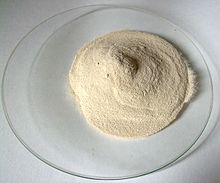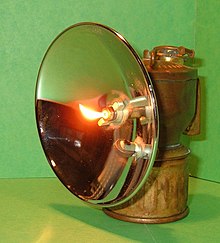Calcium carbide
In the presence of trace moisture, technical-grade calcium carbide emits an unpleasant odor reminiscent of garlic.Calcium carbide is produced industrially in an electric arc furnace from a mixture of lime and coke at approximately 2,200 °C (3,990 °F).[7] This reaction was an important part of the Industrial Revolution in chemistry, and was made possible in the United States as a result of massive amounts of inexpensive hydroelectric power produced at Niagara Falls before the turn of the 20th century.[9][10][11] In Jajce, Bosnia and Herzegovina, the Austrian industrialist Josef Kranz and his "Bosnische-Elektrizitäts AG" company, whose successor later became "Elektro-Bosna", opened the largest chemical factory for the production of calcium carbide at the time in Europe in 1899.Today acetylene is mainly manufactured by the partial combustion of methane or appears as a side product in the ethylene stream from cracking of hydrocarbons.In China, acetylene derived from calcium carbide remains a raw material for the chemical industry, in particular for the production of polyvinyl chloride.While these lamps gave steadier and brighter light than candles, they were dangerous in coal mines, where flammable methane gas made them a serious hazard.[20][21] These impurities can be removed by passing the acetylene gas through acidified copper sulfate solution, but, in developing countries, this precaution is often neglected.



Preferred IUPAC nameCAS NumberChemSpiderECHA InfoCardEC NumberPubChemCompTox DashboardSMILESChemical formulaMolar massDensityMelting pointBoiling pointSolubility in waterAcetyleneCrystal structureSpace groupCoordination geometryStd molarentropyStd enthalpy offormationOccupational safety and healthGHS labellingPictogramsHazard statementsNFPA 704Autoignitiontemperaturestandard statechemical compoundcalcium cyanamidetechnical-gradecalcium oxidecalcium phosphidecalcium sulfidecalcium nitridesilicon carbidecarboncarbide lampselectric arc furnaceendothermic reactiongraphitehydrolysisphosphineIndustrial Revolutionhydroelectric powerNiagara FallsT. L. WillsonH. MoissanBosnia and Herzegovinahydroelectricrock-salt structurepolymorphscalcium hydroxideFriedrich WöhlerCa(OH)2chemical industrypolyvinyl chloridenitrolimecyanamidedesulfurizationpig ironcast irondeoxidizerCarbide lampmethanesafety lampsDavy lampcoppersilverPotosíBoliviacaversheadlampsethyleneripening agentarsinecopper sulfateBig-Bang Cannonbamboo cannonssignal flaresHolmes' Marine Life Protection AssociationBibcodeGreenwood, Norman N.Butterworth-HeinemannPlant Physiol.Algemeen DagbladThe Periodic Table of VideosCalcium compoundsCa(ClO)2Ca(ClO3)2Ca(ClO4)2Ca(BrO3)2Ca(IO3)2CaH2S2O6Ca(NO2)2Ca(NO3)2Ca4(PO4)2OCa3(PO4)2CaHPO4Ca(H2PO4)2Ca2P2O7Ca3(AsO4)2Ca(CN)2Ca(HCO3)2Ca2SiO4Ca3(BO3)2CaAl2O4Ca3Al2O6Ca(MnO4)2CaCrO4CaTiO3CaC2O4Ca(HCO2)2Ca(CH3CO2)2Ca(C3H5O2)2CaC4H2O4Ca3(C6H5O7)2C3H7CaO6PCa(C6H5O5S)2Ca(C6H7O6)2C10H11CaN4O8PCaC10H12O4N5PO4C10H16CaN2O8C12H22CaO14C14H26CaO16C18H32CaO19C36H70CaO4